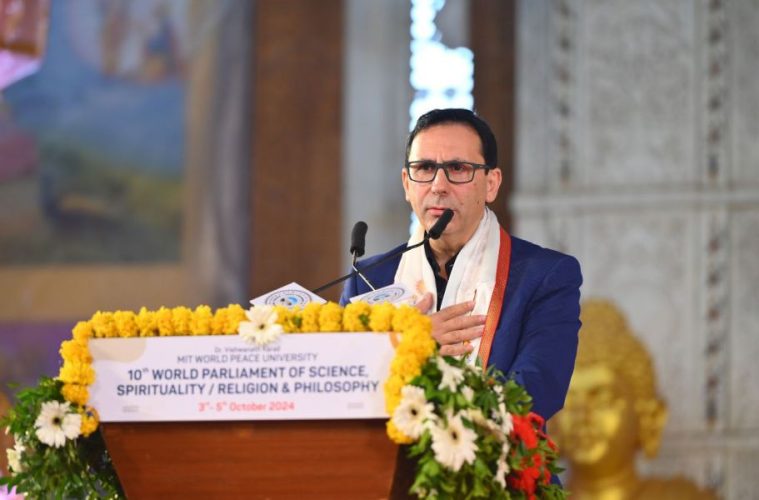Can we create a Peace AI Mathematical Code? A World Peace Humanity Index

Categories :
Here are the excerpts of my keynote at the World Peace University on the 3d October 2024 on the occasion of the 10th World Peace Parliament of Science, Religion and Philosophy 2024: A Global Confluence for Peace and Understanding, where I presented the Peace AI Mathematical Code, a World Peace Humanity Index.
Can we create a World Peace AI Mathematical Code? A World Peace Humanity Index?
When I first met Rev. Prof. Vishwanath D Karad at Oxford Business School, his energy and life’s work deeply changed me! Today, being at the 10th World Peace Parliament of Science, Religion, and Philosophy 2024 is a driver of spiritual strength and love for Humanity and wisdom, science and technology.
I have been inspired by Dr Karad's devotion to peace, science, religion and philosophy, his wonderful educational institution (MIT World Peace University), and by rethinking how important his work and The World Peace University are to the world, especially in a time that is being redesigned, as we speak, by artificial general intelligence (AGI).
In our recent discussion, Dr Karad asked me if we could create a peace formula?
Well, this is something I have been working and researching: A Peace Mathematical Formula!
So, how can we use science, technology and AI to the betterment of humanity and create a Peace Mathematical Code? ‘A World Peace Personal And Organisational Index’?
Let’s begin with the direction laid down by the greatest peace-lovers of all times, Mahatma Gandhi:
“If we are to reach real peace in this world, and if we are to carry on a real war against war, we shall have to begin with the children.” - Young India, on 19 November 1921.
“Non-violence is the first article of my faith. It is also the last article of my creed.” - A speech at Shahi Bagh on 18 March 1922, on sedition charges.
“In my humble opinion, non-cooperation with evil is as much a duty as is cooperation with good.” - Speech in Ahmedabad, 23 March 1922
According to me, peace is a simple, yet extremely powerful concept. Peace is an essential goal for the entire humanity. It has been a subject of philosophical debate, political endeavour, and academic inquiry for millennia.
However, to understand peace in a quantifiable, actionable manner, we need to go deeper in the nature of humanity.
The word peace comes from the Latin word ‘pax’. The ultimate root of pax is thought to be the Proto-Indo-European (PIE) root pak-, which means to fasten, to bind, or to agree upon. This suggests that peace, in its earliest form, was seen as a binding agreement or pact between parties to maintain harmony.
The evolution of humanity: Progression of spiritual/religious behaviours in our society
From the dawn of time, humanity has moved between periods of growth, peace, and conflict. Modern humans, or Homo sapiens, first appeared in Africa roughly 300,000 years ago, evolving from species like H. heidelbergensis or H. rhodesiensis, which were themselves descendants of H. erectus.
By about 160,000 to 70,000 years ago, humans were exhibiting signs of behavioural modernity, with advances in communication, tools, and culture that marked the beginning of significant human development.
The emergence of spirituality and religious behaviour, though difficult to point exactly, likely began during the Middle Paleolithic era, between 45,000 and 200,000 years ago. Archaeological findings provide evidence of ritualistic practices, indicating early spiritual thought.
Some of the most significant artefacts from the Upper Paleolithic period (50,000–13,000 BCE) reveal connections to early religious beliefs. Examples like the lion man, Venus figurines, and the ritual burial at Sungir suggest that humans were engaging in practices that expressed symbolic thinking and spiritual ideas.
For most of human history, societies were sustained by hunter-gatherer lifestyles until about 12,000 years ago, when a transformative shift known as the Neolithic Revolution took place.
The development of agriculture first occurred in Southwest Asia and gradually spread across the globe. This shift to farming independently emerged in regions like Mesoamerica, China, Papua New Guinea, and parts of Africa, fundamentally altering the trajectory of human societies by enabling permanent settlements, the rise of complex civilizations, and advances in culture and technology.
The urban revolution took place in the 4th millennium BCE with the development of city-states, particularly Sumerian cities located in Mesopotamia humanity as we somehow define it now in a civilisation way started. It was in these cities that the earliest known form of writing, cuneiform script, appeared around 3000 BCE. Other major civilisations to develop around this time were Ancient Egypt and the Indus Valley Civilisation.
Fast forward 5000 years - we now reach the 20th century.
The 20th century marked one of the most historically turbulent eras, featuring two World Wars, colonial uprisings, and numerous regional conflicts.
Yet, in the aftermath of the Second World War, while global conflicts have continued, their nature has shifted. Despite a relative reduction in large-scale wars, perceptions of peace and war remain complex, with smaller-scale or regional conflicts like the ones we are experiencing as we speak and global crises (such as financial, terrorism and cyber warfare, fake news, digital and tech disruption) perpetuating an intensifying sense of unrest.
The World Peace Humanity Index: Finding the Science-Religion balance
The duplicity of our human nature is something that can go to extremes of both peace and war, good and evil pursuing both conflict and harmony. Nevertheless, science, spirituality, and religion are still critical to empower us in the new journey of AI and AGI.
“Science without Religion (Spirituality) is lame, while Religion without Science is blind.” - Dr. Albert Einstein
Using AI and Research on the last 12000 years of the maturity of humanity as a civilisation, I tried to elaborate and present a comprehensive framework for ‘A World Peace Humanity Index’.
This is a mathematical model that integrates historical data on ‘Humane’ features, emotional intelligence, ideas, and personalities that ultimately foster progress and balance.
It provides the necessary data on war, conflict, and how nonviolent resistance can be developed using technology and AI.
I challenge all of us and especially the young generation of students at all universities and education institutions to construct this Peace Mathematical Formula and Code collectively.
I repeat my questions:
Can we create a Peace Mathematical Code?
Can we create a World Peace Humanity Index that can foster the very best of our humanity?
Artificial Intelligence helps us lay the Foundations of a ‘World Peace Humanity Index’
We are in a time when AI is becoming the new evolutionary second nature of humanity and we are moving into AGI. At this moment in time we have to rethink how we behave and design our thinking, our humanity operating systems!
Can we create the foundation of a ‘World Peace Humanity Index’ using an AI data-driven approach? Can we create Wisdom + Utopia - Wisdomia that can integrate humanity’s millennial wisdom - that integrates nonviolent concepts from figures like Mahatma Gandhi and Martin Luther King Jr.? Can we draw on the lessons of the last 12,000 / 5,000 years of human history?
By analysing historical data on wars, their causes, and their outcomes, as well as identifying key patterns between peace and conflict, we can establish a mathematical framework for understanding the conditions that foster or inhibit global peace.
If we look at the major historical conflicts we can list:









